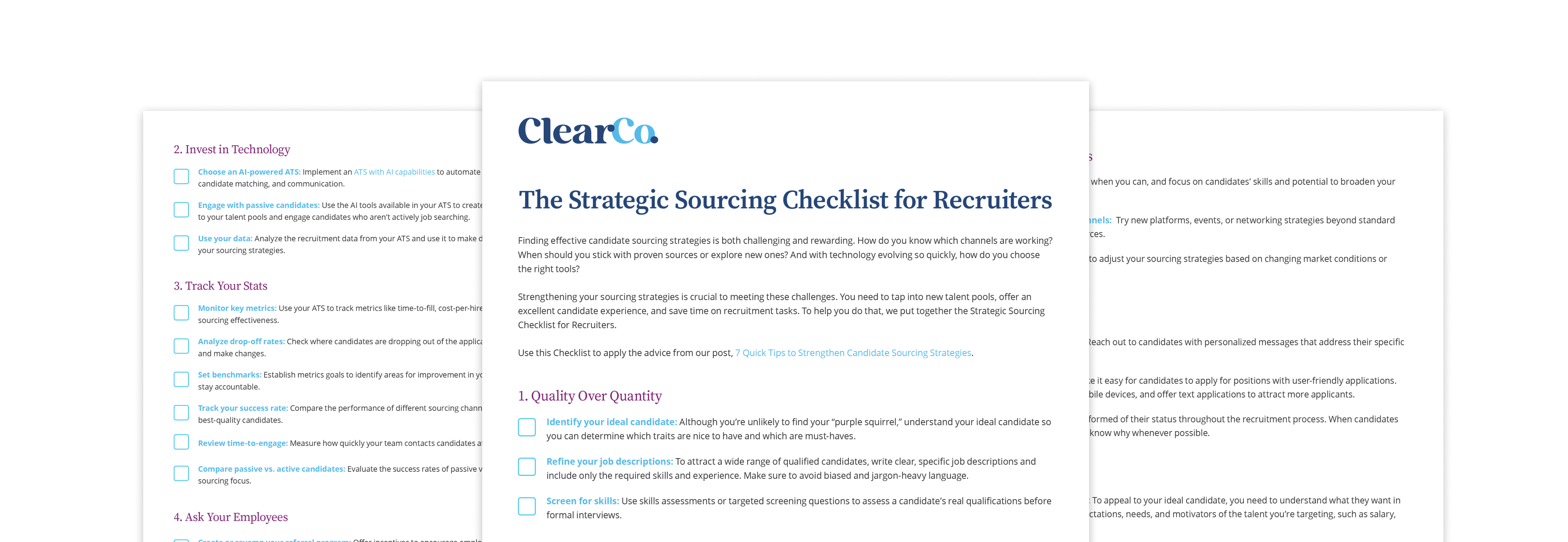Is your company among the one-third that say their hiring processes will be run entirely by artificial intelligence (AI) in 2026? Whether it’s already integral in your talent acquisition strategy or you’re still a beginner, there’s no time to put AI on the back burner. HR, recruiting teams, and hiring managers need to understand its capabilities for their organizations — which tasks AI can automate, what it can augment, and what to leave in human hands.
By now, it’s clear that integrating AI with talent acquisition is the key to competing for top talent. Lean in now so you can hire smarter, move faster, and build more inclusive teams in 2026.
Keep reading to dig into how AI is reshaping the talent acquisition landscape, and how you can make it work for your hiring goals — confidently and responsibly.
Can AI transform your hiring? 🤖 Check out the 2026 guide to see what’s possible!👇 #AI #HRTech
What Is AI in Talent Acquisition?
Artificial intelligence in talent acquisition is when companies apply advanced technologies, like machine learning, natural language processing, and predictive analytics, to recruitment and hiring processes. AI solutions like AI-powered ATSs (applicant tracking systems) can analyze huge amounts of data at lightning speed. They help your recruiting team identify top candidates, detect patterns in candidate behavior, and streamline any repetitive steps.
With AI, you can screen resumes automatically and surface top candidates based on their potential fit for the role. AI assists with writing tailored job descriptions and messages to candidates. Your team regains valuable time they can use to focus on evaluating candidates and building relationships with new hires.
AI gives your team the power to work more efficiently, execute more consistent processes, and get deeper talent acquisition insights. Use it to build stronger talent pipelines, reduce bias, and make faster, data-informed hiring decisions in a market where every advantage counts.
5 Practical Use Cases for AI Talent Acquisition
AI-driven recruitment processes save time, improve efficiency, and support better decision-making. Here are some practical ways companies are using AI to enhance their talent acquisition strategies.
1. Automated Resume Screening
When jobs posts get hundreds or thousands of applications, your recruiters end up spending countless hours sifting through resumes that don’t meet your qualifications. AI recruitment tools can take on this heavy lifting by parsing all of those resumes and applications in a fraction of the time. Using your criteria, candidate sourcing AI identifies talent whose skills and experience align. That produces a qualified shortlist so your team can start engaging the most promising applicants faster than ever.
2. AI for Candidate Engagement
Candidates want to hear from recruiters, but all too often, they don’t get a response for weeks on end, if ever. 48% of candidates said they’ve been ghosted by at least one company in the past year. But with AI-powered tools, like Generative AI and HR chatbots, you can keep candidates informed at every stage.
With GenAI tools, your talent acquisition team can quickly write personal messages to candidates and include automatically generated links for immediate interview scheduling. AI-powered chatbots on your careers page answer applicants’ questions about open roles, company culture, and benefits 24/7. They can even conduct initial screenings and help schedule interviews. Your candidates aren’t left waiting and your team saves valuable time — while reducing time-to-hire.
3. Predictive Analytics for Best-Fit Hiring
AI models allow you to make more objective decisions about who to hire. Predictive analytics tools examine traits and behaviors of top performers to highlight what actually drives success and retention at your organization. Rather than relying on gut feeling, AI-driven analytics gives your team concrete evidence to back up decisions and set the stage for smarter, more equitabl hiring. It’s no surprise 74% of companies said AI has improved their quality-of-hire.
4. Video Interview Assistance
Interviews typically require recruiters to take thorough notes — it’s essential to get the details right to find the best candidate. But note-taking distracts recruiters from connecting with candidates, interrupting conversation and taking up valuable interview time. AI enables better interviews with interview assistant tools, like an AI notetaker. The AI notetaker creates a transcript of the interview they can review later so your recruiters can focus on getting to know candidates.
AI is transforming hiring! 📈 Learn how to use it wisely — check out the quick 2026 guide. ✨
5. Personalized Candidate Outreach
Sometimes, the right people aren’t actively job hunting. AI gives recruiters a smarter way to reach those passive candidates. AI solutions can surface candidates in your talent pool with the best-fit backgrounds, then automate outreach that speaks to their experience. That’s much more effective than sending mass emails listing your open roles.
This targeted approach increases response rates and frees up time for recruiters to focus on meaningful conversations, and it’s proven. Hiring teams are saving 20% of their time each week — one full workday.
5 Benefits of Using AI in Talent Acquisition
With at least half of companies are already using AI in recruiting and hiring, there’s no time to waste getting on board. Fortunately, implementing this new tech doesn’t just help you stay competitive. Your business can reap lots of benefits when you use AI ATS capabilities.
1. Faster Candidate Screening
You need to move fast to snap up top candidates in today’s hiring market — they’re off the market in just 10 days. With AI, your team cuts down on time-consuming manual tasks like resume screening and candidate ranking, streamlining the first screening round. Nearly two out of three recruiters now use AI in the recruitment process, and most say it’s making the front end of hiring much more efficient.
2. Improved Hiring Quality
AI is both fast and thorough, matching candidates to your roles by comparing what you need and past indicators of success to their skills and experience. That makes it clearer to your team which applicants are most likely to thrive. AI analytics built into your ATS help recruiters focus on the qualities that truly indicate great hires, rather than relying on their intuition.
3. Faster Time-to-Fill
Roles don’t stay empty as long when admin chores like resume screening and interview scheduling are handled by smart automation. This frees up recruiters to move top candidates quickly through the process and fill needed positions before competitors do.
4. Data-Driven Insights
Recruiting shouldn’t feel like a guessing game. With AI, you can actually see which channels deliver the strongest candidates and spot bottlenecks as soon as they develop. Dashboards and reports put the facts in front of you so you can making hiring decisions backed by real, recent information.
5. Cost and Resource Efficiency
AI takes repetitive work off your recruiting team’s plate, making it possible to increase efficiency without adding extra hands. That saves time and cuts your cost per hire by reducing unnecessary spending on channels that don’t deliver. Over time, as you make smarter hiring decisions, you retain more employees and spend less money replacing those that weren’t a good fit.
When organizations put AI to work for their teams, they see improvements in speed, quality, and resource management. That creates a competitive edge that’s hard to ignore.
4 Common Challenges of Using AI for Talent Acquisition
AI’s transformative potential in hiring is clear, but its adoption brings important challenges that you can’t ignore. Understanding these pitfalls — and grounding hiring strategies in data — lays the foundation for responsible AI use.
1. Bias and Fairness Risks
AI algorithms carry a risk of bias if they’re trained on the wrong data. Without human oversight, qualified candidates and underrepresented groups can get screened out. It’s important to ensure AI-enabled screening still includes humans and is regularly audited as talent acquisition teams continue using it more.
2. Data Privacy and Compliance
Handling large volumes of candidate data raises the stakes for privacy protection. Just 26% of job candidates said they trust AI to evaluate them fairly, reflecting their concerns transparency and data handling in addition to bias. If you’re using AI, ensure you communicate how candidate data is used, stay compliant with applicable regulations, and commit to ethical AI use.
3. Overreliance on Automation
AI’s strong suit is automating repetitive work, but be careful not to become overly dependent on the technology. Gallup research shows that while 93% of CHROs are using AI, most employees say they don’t understand how it’s being used or are not comfortable using it.
Be sure to introduce AI alongside guidance about when to use it and how to do so responsibly. That way, you retain the essential human judgment and context required for using automation effectively.
4. Balancing Tech With Human Touch
AI can help you move faster, but it can’t replace the human connections that turn good candidates into enthusiastic new hires. The conversations, careful listening, and genuine interactions are what set a company apart. 96% of senior HR leaders see AI as a way to support, not replace, their recruiting and HR teams. For a winning recruitment strategy, let technology handle the workflows while keeping people at the center of the process.
How to Use Talent Acquisition AI Responsibly
Using AI responsibly requires a plan for maximizing the benefits and minimizing the risks. Follow these guidelines for a fair, effective AI-enhanced recruitment strategy.
1. Define Clear Objectives
Identify and understand what you want AI to accomplish, whether that’s reducing time-to-fill, improving candidate quality, or expanding your reach to new talent pools. That way, your AI tools and automated processes actually serve your goals.
2. Audit Data for Accuracy and Diversity
Review your hiring data for accuracy and diversity before using it to train any AI system. Clean, accurate data helps minimize bias from the start.
3. Set Up Ongoing Bias Monitoring
Keep consistent watch on AI recommendations and hiring outcomes to catch and address bias early. That ensures your process stays fair over time.
4. Train Recruiters on AI Talent Acquisition Tools
Equip your team with the knowledge they need to use AI thoughtfully. Emphasize balancing automated insights with human experience. AI tools should add value rather than replacing your judgment.
5. Start Small and Scale
Pilot new AI tools on a small scale first to measure results, gather feedback, and make adjustments before rolling them out across departments.
Leverage AI in Your Talent Acquisition Strategy With ClearCompany
Turn hiring from a guessing game to a data-driven strategy. With thoughtful AI integration, you can speed up your hiring process, spending less time sorting resumes and more time connecting with great candidates.
Curious how ClearCompany’s AI-powered solutions can help you hire smarter and faster? Book a demo and let us show you what’s possible.

.png)
